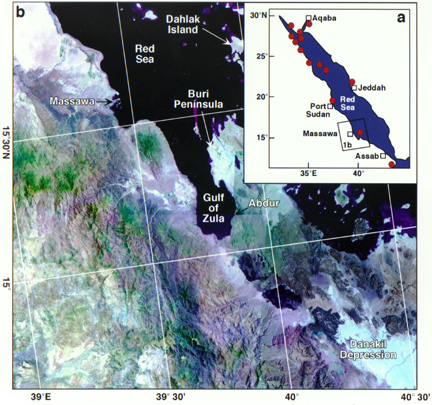geotimesheader
News
Notes
Paleoanthropology
Beach Party,
125,000 B.C.
Summertime is prime time for beach season — when
the seashore beckons much of the human race to hit the waves. But when
did humans first venture toward the oceans? New research suggests humans
have been adapted to seaside living for at least 125,000 years.
| Researchers combing the Pleistocene-age Abdur
Reef Limestone of Eritrea found not only edible mollusks and land mammal
remains, but also flat, teardrop-shaped hand axes alongside more technologically
advanced obsidian flake and blade tools. In the midst of a country at war
with Ethiopia, the scientists found the first clear evidence of shoreline
occupation. Previous findings of seashell-littered inland rock shelters
only hinted at human activity near the coast. “We found stone
tools in excellent, albeit unusual, geological context that is eminently
datable,” says Robert C. Walter of the Departmento de Geologica, Centro
de Investigaciôn Cientifica de Educación Superior in Ensenada,
Mexico, who led the international team of researchers through two field
seasons in 1998 and 1999. Their discoveries suggest more than the origins
of beach fever. Early coastal adaptation may add support to the “Out of
Africa” theory of early human migration. |

(a) An inset map of the Red Sea basin shows red circles depicting areas
of last interglacial
coral terraces. (b) A Landsat Thematic Mapper image of the study area shows
the Abdur
Reef Limestone and the archaeological sites near the village of Abdur (arrow).
M. Abdelsalam, University of Texas at Dallas. |
Walter and colleagues reported in the May 4 Nature
the latest development in a broader investigation of East African Rift
geology. “I began this project — with Dick Buffler at UT-Austin’s Institute
for Geophysics — with the notion that we wanted to do it a bit differently
than had been done before in East Africa,” Walter says. His geologic and
anthropologic studies in other fossil and artifact-rich East African rift
valleys convinced him that geologic units within Eritrea would also yield
an archaeological bounty.
“We were of course interested and fascinated by
the human origins potential of Eritrea, but we recognized that we have
an opportunity and obligation as geologists to bring more to the story
than the fossils and artifacts alone.” As a result, he and his colleagues
investigated the geological history of the Danakil Rift Valley of Eritrea,
including the origin and evolution of Cenozoic rifting, sedimentary basin
formation and local rift volcanism, and the effects of climate change as
recorded in the region’s sediments, fossils and artifacts. “We are, in
short, after the big picture,” Walter says.
The breakthrough for the Eritrean discovery is
the relatively precise geologic context for the artifacts. The team applied
thermal ionization mass spectrometry (TIMS) to Uranium-Thorium dating,
a method pioneered in part by team member R. Lawrence Edwards of the University
of Minnesota. This method for dating corals relies on the solubility of
uranium-234 in sea water, and the insolubility of thorium-230. From
a set of five aragonitic coral specimens, the researchers dated the Middle
Stone Age (African Middle Palaeolithic) artifacts found on the raised fossil
reef to the last interglacial: 125,000 (plus or minus 7,000) years before
the present.
According to Walter and his team, shoreline occupation
dating back to 125,000 years ago supports the “Out of Africa” theory of
human evolution. While scientific consensus dictates that our ancestors
originated on the African continent, the timing and method of dispersal
into other continents remain controversial. The “Out of Africa” theory
asserts that early humans evolved within the continent 100-200 thousand
years ago and then spread outwards, colonizing the rest of the planet and
displacing other hominid species. Walter and his team suggest that human
coastal exploitation over 100,000 years ago allowed the more advanced humans
to travel along the coasts from Africa to the rest of the Old World. Later
isolations may have led to the genetic variation we see today.
In contrast, the “Multiregional evolution” hypothesis
asserts that our ancestors left Africa much earlier and interbred for millennia,
implying that the last major human evolutionary bottleneck occurred as
much as 2 million years ago (Geotimes, March 2000). Under this view,
European, Asian and African groups resulted not from recent genetic isolation,
but from a variety of environmental factors that impacted a larger, intermingling
population.
John Hawks of the University of Utah, a proponent
of the multiregional evolution hypothesis, is not convinced that the Eritrea
finds strongly support the “Out of Africa” view. “While ‘Out of Africa’
requires that [coastal use] innovations occurred exclusively in Africa,
the Multiregional model makes no prediction about where new behaviors should
emerge,” Hawks says. “Africa is just as likely a place as any.”
Walter strongly disagrees. “One must conclude,”
he says, “that positive evidence on one hand far outweighs a lack of evidence
on the other.”
But Hawks also suggests that genetic evidence
used by the “Out of Africa” theory’s proponents imply that Africa’s population
size 50,000 years ago was small. “Genetics and archaeology are not telling
us one picture about what happened during this time,” Hawks says, “and
I think that’s very interesting.”
While the debate continues, the recent discoveries
of Walter and co-authors prove that previously under-explored coastal sites
are now a high priority for scientific research. These sites may provide
the key archaeological finds from the late Pleistocene that eluded researchers
at inland sites.
“Our discovery now opens the door for other coastal
sites to be explored,” Walter says, “and for the beginning of interesting
debates on [their] significance.”
Josh Chamot
Geotimes contributing
writer

